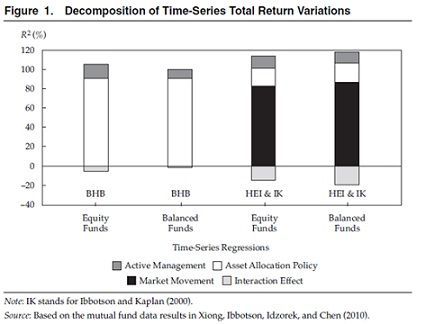Article
A Rising Tide Lifts All Boats (and Some Egos)
Author(s):
No matter how good of a money manager someone thinks he is, much of stock market performance can be attributed something outside of an investor's control.
Every once in a while a male corners me (never a female). He wants to engage in a discussion about his investments. Often, he is recently retired. In the conversation, after some preliminary investment chit chat, the initiator gets down to his agenda. It is to tell me how smart he is about investing and that his earnings reflect it.
Of course, I am happy for him that he is happy. However, I am not impressed and I’m not sure he should be either. Anyone who believes he is outsmarting the market and others likely is fooling himself. This is because facts suggest otherwise. Though 12.5% of stock market performance is due to the manager (who would be my conversation partner) and another 12.5% to asset allocation (also attributed to the manager), the majority, 75%, is attributed to something no one can control — market momentum.

The above is a simplified summary taken from Robert Huebscher's paper based on the data from Rober Ibbotson, et.al. 2010.
This concept is different than the previous wisdom reported by Gary Brinson and others in 1986. They published a seminal paper that reported that asset allocation — the process of parceling investments among different classes of stocks and bonds — was responsible for 90% of market returns.
Roger G. Ibbotson and associates reported in the Financial Analysts Journal, volume 66, #2 in 2010 that this was erroneous information. In their analysis it was discovered that Brinson and associates used mathematical testing that had countered against market movement. When this was corrected, market movement became the most important contribution to performance. These results are illustrated below taken from “Asset Allocation Matters, But Not as Much as You Think,” by Robert Huebscher based on the data from Ibbotson, et.al. 2010. The time period was 1999-2009.

Early study (left side of chart): BHB
Brinson, et al., 1986;Several later studies (right side of chart): HEI
Hensel, Ezra and IIkiw, 1991; IK
Ibbotson and Kaplan, 2000.
— — — The bars in the figure show how the four factors explain the variation of returns: active management, asset allocation, market movements and an interaction effect. BHB (two bars on the left) did not differentiate between asset allocation and market movement; all variation was credited to asset allocation. The more recent analysis (two bars on the right) shows something different — the domination of market movements after they have been separated from asset allocation.
Ibbotson, who is credited with this along with some colleagues, is a professor of finance at Yale University. He is also the founder and former chairman of Ibbotson Associates, now part of Morningstar. His main role at present is as chairman and chief investment officer of Zebra Capital.
In summary, according to the work of Ibbotson et al., a rising wave lifts the entire stock market just like it elevates all boats. It seems, however that it can elevate something else as well — egos, warranted or not. The main message here though is not that. Instead, it is to appreciate how important it is to be in the market consistently according to your risk preference. Otherwise, you could miss the rising tide.
For further reading: Retirees, Idle Hands Are a Debtor's ToolsThis information and content is offered for informative and educational purposes only. MyMoneyMD, LLC is not acting as a Registered Investment Advisor, Investment Counsel, Tax Advisor, or Legal Advisor.




